Define lesson properties
After creating a lesson using the Lesson Editor, you can then define the properties specific to that lesson to control how a student completes the lesson.
Defining lesson properties is done on the Properties tab of the Lesson Editor.
Properties that can be defined in the Lesson Editor are:
- Short name — Quick reference name for the new lesson.
- Description — Summary of the lesson’s learning objectives.
- Policy Set — Choose a collection of predefined properties to control how a student completes and reviews their lesson or choose to not use a Policy Set and completely customize these properties.
- Advanced Policies — Define minimum competency requirements for the student to be able to attempt the lesson.
- Scheduling & Visibility — Control the lesson visibility and availability to your students.
- Reporting — Define an email address to receive update notifications on student lesson completion.
- Text to show at the head of each page — Define the message that appears at the top of each page of the lesson.
- Text to show on the results page — For a lesson that can be submitted, define the message that appears on the results page.
- IP Address/Host Names Whitelist — Control which computers can be used to complete the lesson.
NOTE: A new lesson that's created in a parent class is automatically inherited (except for the Text to show at the head of each page and Text to show on the results page) by a child class. Changes to that parent class’s lesson are inherited by a child class as follows:
- Changes to the lesson name, short name, and description are inherited
- Changes to the text to show at the head of each page and on the results page aren't inherited
- Changes to the lesson questions are inherited
- Changes to the lesson properties aren't inherited
- Changes to the lesson Policy Set (if a Policy Set was applied) are inherited
Only certain components of an inherited lesson can be edited within child class. Check out Edit a lesson. These edits will only apply to that child class and its descendants.
Define lesson properties with the Lesson Editor
To define the properties of the new lesson that you created from the Design tab of the Lesson Editor:
NOTE: You may have to click the expand icon![]() to view certain properties.
to view certain properties.

Click the 2. Properties tab in the Lesson Editor.

Define a shortened name for the lesson.

Define a description of the lesson.

Click Advanced Policies to set the Advanced Policies for your lesson.

TIP: Check out Define Advanced Policies for help with defining the Advanced Policies for your new lesson.
Select an existing Policy Set from the drop-down list. A read-only preview is displayed of the selected Policy Set (if you do not want to use an existing Policy Set and want to fully customize the properties for this lesson, see step 6). If you have selected a Policy Set, skip to step 11.
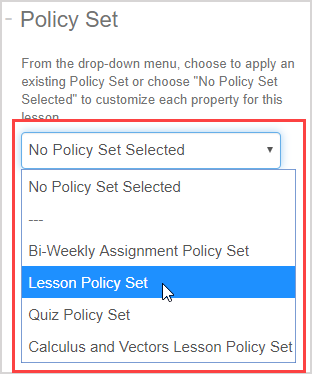
To fully customize the properties for this lesson (instead of applying an existing Policy Set), select No Policy Set Selected from the drop-down list.
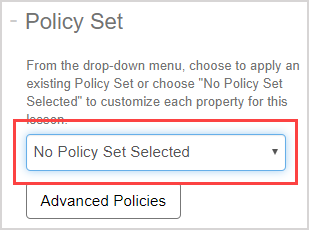
If no Policy Set is being applied to this lesson, customize the General Properties for this lesson:
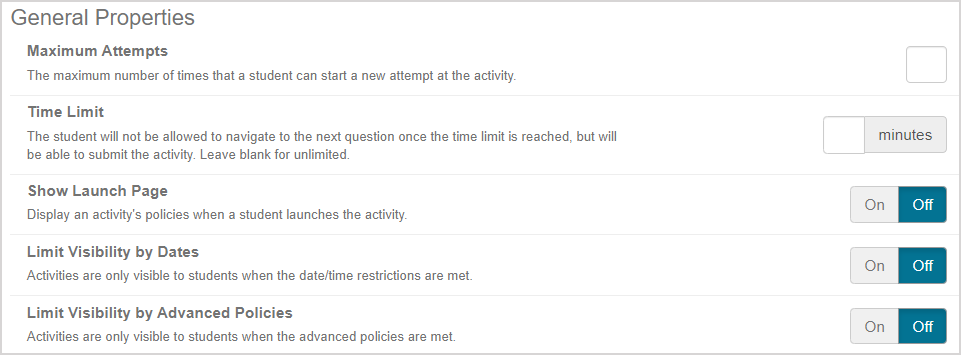
| Property | Default setting | Explanation of property |
|---|---|---|
| Maximum Attempts | Unset | Enabled — Set the maximum number of allowed attempts at this activity. Enter any number up to 3 digits. If the student exceeds the maximum number of allowed attempts, a message displays prior to the start of the final attempt indicating the attempt restriction. For an exception after the allowed maximum number of attempts, a student can click Request Exception (at the start of the illegal attempt) and a proctor or instructor must log in to permit the additional attempt. Disabled — Leave unset for an unlimited number of allowed attempts. |
| Time Limit | Unlimited | Enabled — If a time limit is set (measured in minutes), the time remaining to complete the activity is continuously displayed while the activity is in progress. The timer flashes red for 10 seconds when 5 minutes remain. The timer is red for the remaining time, and flashes again when the time limit has expired. If the time limit expires while the activity is in progress, the student will not be allowed to navigate to the next question or enter responses. However, the student is still able to submit their activity (whether all questions are completed or not). The timer does not stop until the student runs out of time or clicks Submit Lesson. The timer will continue to run even if the student clicks Quit & Save. Disabled — Leave blank for unlimited time limit (no time limit). |
| Show Launch Page | Off | On — When a student begins their attempt, the first screen displayed is a preview of the activity properties. Off — The student is not given a preview of the activity properties and immediately begins their attempt. |
| Limit Visibility by Dates | Off | On — The activity is only visible to the student on their Class Homepage and calendars from the defined Start Dates/Times to the End Dates/Times. Off — The activity is always visible to the student on their Class Homepage and calendars outside of the Start and End Dates/Times but unavailable for attempts. |
| Limit Visibility by Advanced Policies | Off | On — The activity is only visible to the student on their Class Homepage and calendars if the student has satisfied the Advanced Policies. Off — The activity is always visible to the student on their Class Homepage and calendars regardless of the requirements of the Advanced Policies. |
NOTE: If the Maximum Attempts property is defined, the Show Launch Page property is automatically enabled.

NOTE: Using an adaptive question in an activity with a time limit applied does permit the student to complete the entire adaptive question even after the time limit has expired. However, the student won't be able to navigate to another question once the time limit has expired. Check out Author an adaptive question for more information on authoring adaptive questions.
If no Policy Set is being applied to this lesson, customize the Feedback (During) properties that control what is allowed while the lesson is in progress:
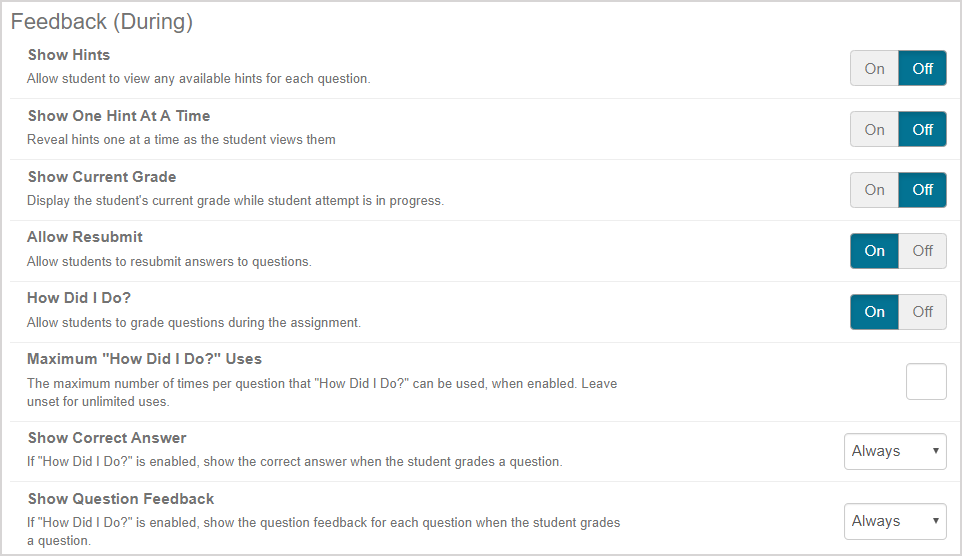
| Property | Default setting | Explanation of property |
|---|---|---|
| Show Hints | Off | On — The student can view available hints for each question. Off — No hints are revealed to the student. |
| Show One Hint At A Time | Off | On — Reveal hints 1 at a time when Show Hints is enabled. Off — All available hints for a question will be revealed simultaneously when Show Hints is enabled. |
| Show Current Grade | Off | On — Display the student’s current grade for the activity while it is in progress. Off — Do not display the student’s current grade for the activity while it is in progress. |
| Allow Resubmit | On | On — Once a student has submitted a response to a question and moves on to the next question, they are allowed to return to a previous question to re-enter a response. Off — Once a student has submitted a response to a question and moves on to the next question, they can’t return to a previous question to re-enter a response. |
| How Did I Do? | On | On — The How Did I Do? button is visible for the student to click to check the correctness of their response while the activity is in progress. Off — The How Did I Do? button isn't visible and the student can’t check the correctness of their response while the activity is in progress. |
| Maximum "How Did I Do?" Uses | Unlimited | Enabled — A maximum number of times per question that a student can use the How Did I Do? function. Disabled — Leave blank for unlimited usage of the How Did I Do? function. |
| Show Correct Answer | Always | Choose to display the correct answer when a student uses the How Did I Do? function during the activity. Choose from:
|
| Show Question Feedback | Always | Choose to display feedback (response-level feedback and question feedback) when a student uses the How Did I Do? function during the activity. Choose from:
|
IMPORTANT: Use caution with some combinations of properties. Example — Enabling Show Current Grade and How Did I Do? will permit students to get immediate feedback on questions and then retry the activity.
If no Policy Set is being applied to this lesson, customize the Feedback (After) properties that control what is visible to the student after the lesson is graded and recorded in the Gradebook:

| Property | Default setting | Explanation of property |
|---|---|---|
| Show Final Grade | On | On — Display the student’s final grade achieved for the activity. Off — Do not display the student’s final grade for the activity. |
| Show Correct Answer | If Incorrect | Choose to display the correct answer for each question when the activity is graded. On the final results screen, the student will have the option to print their results. Choose from:
|
| Show Question Feedback | Always | Choose to display question feedback for each question when the activity is graded. On the final results screen, the student will have the option to print their results. Choose from:
|
If no Policy Set is being applied to this lesson, customize the Only Applicable to Lessons properties that control how the lesson is categorized as complete:

| Property | Default setting | Explanation of property |
|---|---|---|
| Complete When | Viewed & Attempted & Passed All Sections | Choose when the lesson will be considered complete based on the student meeting the conditions from the drop-down list. The completion status determines when to show a check mark on the Class Homepage and in the Gradebook. Advanced Policies, when applied to a lesson, also use this setting to determine completeness to allow a student to progress to the next lesson. Choose from:
|
| Allow Submit | Off | On — A Submit Lesson button is provided to the student and the lesson functions as an assignment. Submitting the lesson will generate a grade and will reset the state of all questions in the lesson for subsequent attempts. Off — The lesson is not able to be submitted for grading like an assignment. |
Set the Scheduling & Visibility properties for the lesson:

| Property | Default setting | Explanation of property |
|---|---|---|
| Visible (Master) | Enabled | Enabled — The activity is visible to the student on the Class Homepage and calendars. Disable — The activity is hidden from the Class Homepage and calendars and only visible to you in the Content Repository and to the student, if completed, as a past result in the Gradebook. |
| Start Date | Disabled | Enabled — Select the check box for today’s date to autofill. Or, set a specific Start Date (and time) for the activity using the drop-down calendar. This determines the activity availability to the student; the activity can’t be started until this date and time. Before the indicated date and time, the activity is not available to attempt. If scheduling has been set, a calendar icon Disabled — If you do not enter a start date and time, the activity becomes available immediately after it is created. Click clear beside the calendar icon or deselect the check box to disable Start Date. |
| End Date | Disabled | Enabled — Select the check box for today’s date to autofill. Or, set a specific End Date (and time) for the activity using the drop-down calendar. This determines the activity availability to the student; all responses and work on the activity must be entered before this date and time. After the indicated date and time, the activity is not available to attempt. If scheduling has been set, a calendar icon Disabled — If you do not enter an end date and time, the activity remains available indefinitely. Click clear beside the calendar icon or deselect the check box to disable End Date. |
| Restrict Feedback Until | Disabled | Applies to the student viewing feedback and their attempt submission details. Enabled — Select the check box for today’s date to autofill. Or, set a specific date and time using the drop-down calendar to display when feedback and correct answers are revealed. The student won't be able to click View Details after submitting their attempt to view question feedback. The student won't be able to view their attempt details in the Gradebook until this date. This is the Feedback Date on the Class Schedule. Disabled — The student can click View Details after submitting their attempt and view their attempt details in their Gradebook. Click clear beside the calendar icon |
| Schedule Force Grading On | Disabled | Enabled — Select the check box for today’s date to autofill. Or, set a specific date and time using the drop-down calendar for when all active attempts will be force graded. This is the Force Grade Date on the Class Schedule. The time for the system to complete Force Grading may vary. Disabled — Active attempts will not be force graded. Click clear beside the calendar icon |
IMPORTANT: Defining a date for Restrict Feedback Until as after the activity due date has passed is ideal for ensuring activity integrity since students who finish the activity early are prevented from revealing answers to other students.
NOTE: Instructors can view unavailable activities (activities that are visible but not accessible to students) in the Lessons & Assignments pane in the Content Repository.
NOTE: The time zone for scheduling is based on the class time zone setting (which defaults to a Möbius site-wide time zone). Check out Class details fields.
Set the Reporting property for the lesson:

| Property | Default setting | Explanation of property |
|---|---|---|
| Email Reports To | Disabled | Select the Email Reports To check box and enter email address recipients for emails to be sent to when a student completes the activity. A list of email addresses, separated by commas, can be used. The email update contains the following information
|
Insert text in the Text to show at the head of each page text box to display at the top of each page of the lesson.

Insert text in the Text to show on the results page text box to display on the lesson results page if it is being created with the ability to submit for grading.

Set the IP Address/Host Names Whitelist properties for the lesson:

| Property | Default setting | Explanation of property |
|---|---|---|
| IP Address/ Host Names Whitelist | Disabled | Enabled — Only allow computers with matching IP masks or host name patterns to complete the activity. You can select the check boxes of groups defined by your organization's Möbius administrator using the IP Address/Host Name Whitelist (System) list or enter custom groups using the IP Address/Host Name Whitelist (Custom) text entry area. Enter only one IP address or pattern per line. IP addresses can be listed individually, with patterns, with wildcards (Example — *.digitaled.com), or using Netmask format (Example — 10.10.2.*). Disabled — Leave all system groups unchecked and custom groups empty to allow all IPs and Host Names to be used for attempting the activity. |
Click Save & Close to save your lesson and exit the Lesson Editor.

NOTE: Click Save to save your progress and continue working in the Lesson Editor.

Review the lesson summary page.
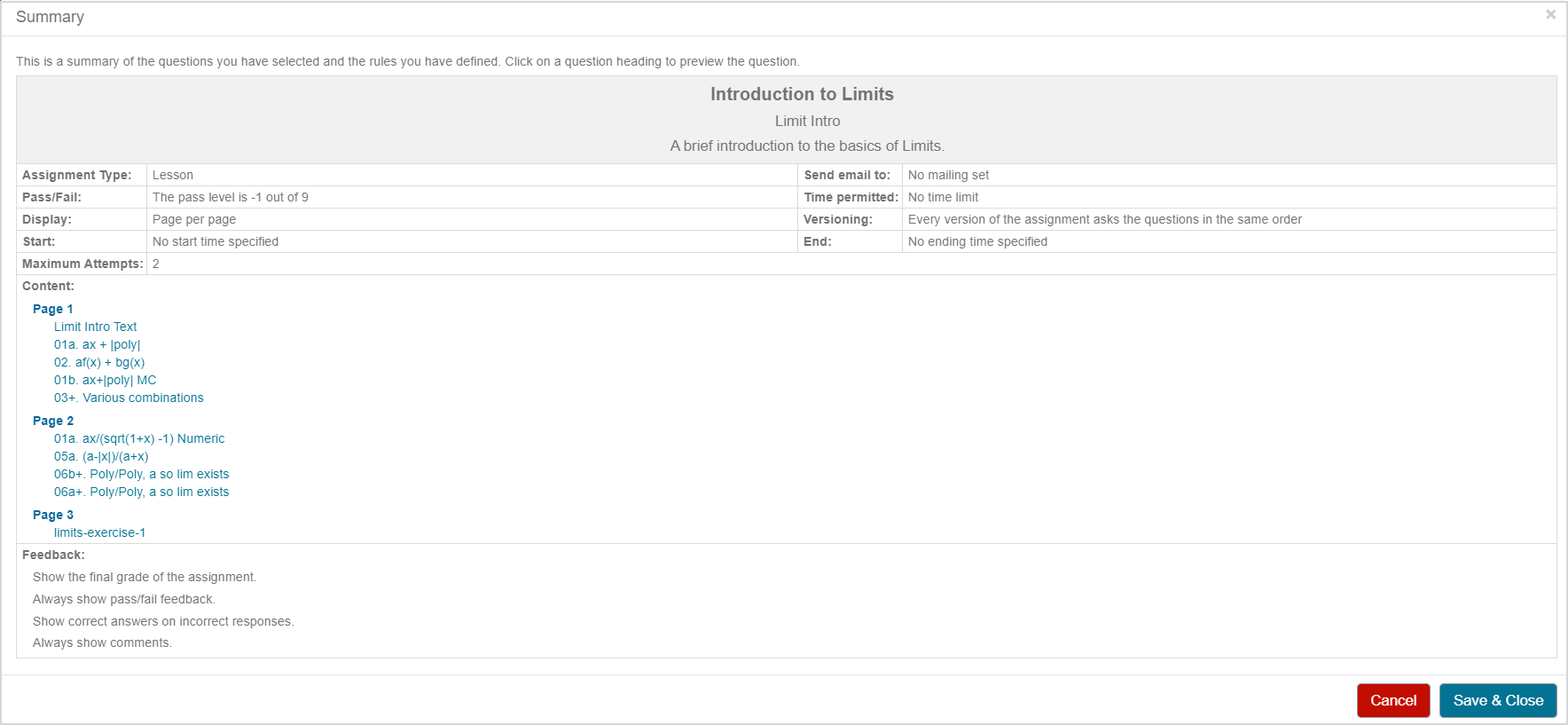
NOTE: To make changes to the properties you defined, click Cancel in the summary window to return to the Lesson Editor.

Click Save & Close to accept the lesson properties. Its visibility and availability to your students on the Class Homepage and Calendar depend on the properties you defined.

NOTE: A parent class’s lesson (comprised of content, properties, and an optional Policy Set) is automatically inherited by a child class when the lesson is created. Any changes to that parent class’s lesson are inherited by a child class as follows:
- Changes to the lesson content are inherited.
- Changes to the lesson properties are not inherited.
- Changes to the lesson Policy Set (if a Policy Set was applied) are inherited.
A child class can edit the inherited lesson’s properties and Policy Set, but these edits will only apply to that child class and its descendants.